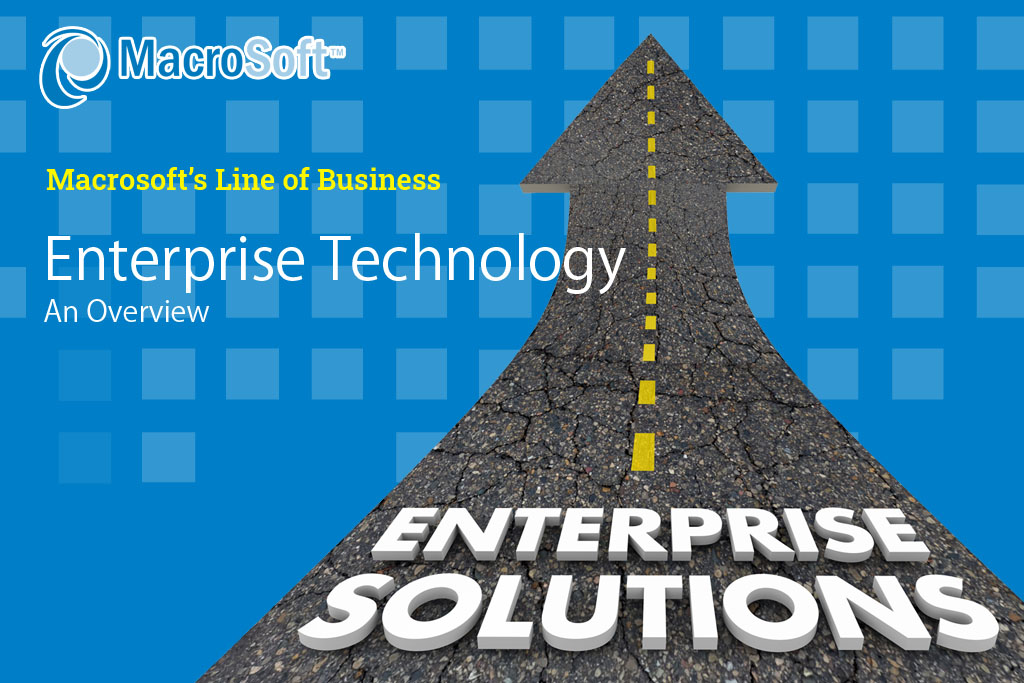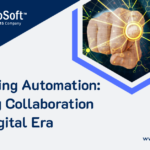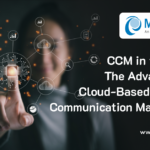

This paper provides an overview of Macrosoft’s Enterprise Technology line of business profiling the main elements of success for a productive working relationship between Macrosoft and the clients we serve. We currently have about 25 companies in this LOB, ranging from startups to companies with annual revenues in the hundreds of millions of dollars. Client engagements are almost always very long-term, involving many successive projects, some being well over a decade and still going strong.
This is an important and growing part of Macrosoft, and we are well positioned to provide the same services to other new companies. To date, we have not ‘marketed’ our work in this area; the clients have come in mainly thru ‘network connections’ and ‘word of mouth’. So, with this paper (and other similar ones we are now posting under this LOB), we are beginning to get the word out.
This is the first in a series of three papers on the Enterprise Technology LOB. The focus of this first overview paper is on profiling the LOB in terms of the types of customers we can serve best, the types of work we do for them, and the general parameters of how we staff and manage our dedicated teams in support of each client. There are four technology and tool stacks that are used most often for our clients:
- Microsoft .Net
- Java
- Open Source including Python; and
- Web Content Management technologies.
The 2nd paper goes into all 4 of these tech stacks in detail. Each tech. stack contains many variants of actual tools that we use for any specific client. Clearly, the tech. stack we use for any client must be consistent with the toolsets that the client prefers to use.
The third paper in this series dives into the operations and processes, communications, infrastructure, development and testing methodology and tools, security measures and disaster recovery we have in place at each of our international facilities. As this 3rd paper clearly shows, these facilities are fully state-of-the-art.
Following this series of three papers, we will also provide a series of short case studies describing the work we do for our many customers; these case studies include discussions of how we got the projects started, the types of IT work provided for clients, and how and why the clients chose to work and remain with Macrosoft.
To begin, our work in this LOB is analogous to a ‘development team’ version of business process outsourcing (BPO). In essentially all cases the development teams remain part of Macrosoft, and we continue to manage them in support of the client.
The teams, established mainly out of our international facilities, become fully integrated with the client’s IT resource teams, in effect they become extensions of the client’s teams. In some projects the client chooses to have a US technical PM, or some cases use overseas technical team to work on behalf of the client. That depends on the level of support the client wants.
The development capacity we provide enables a client to take on new and different applications and get them done in an expedited timeframe to meet critical business needs. The teams we now have in place range from 2-5 team members up to 30 or more team members. The key point to keep in mind, the team sizes and compositions are always dynamic and changing as the client’s needs evolve. That is one of the major value-adds we offer to our clients, namely, to be able to staff the right people with the right skills sets at the right time.
Macrosoft maintains a pool of resources that are best suited for each client’s tech stack. These resource pools are graduated from our Macrosoft University or Talent acquisition program. This method of resource pooling cuts down almost 90% of the onboard time since resources are already trained on the client’s tech stack.
Macrosoft’s Enterprise Technology LOB
The Enterprise Technology LOB supports your business operations by optimizing workflows, improving communication, and providing access to decision making data. Enterprise Technology makes it possible for your entire organization to work effectively to achieve goals. Increased responsiveness, scalability and security are some of the aims of enterprise technology LOB. Under Enterprise LOB, we have 5 dedicated parts:
Enterprise Developments/Outsourcing
We develop custom software solutions catering to solve the problems relating to core business functions, marketing activities, human resources, payroll, inventory management, supply chain distribution management, production, and accounting. Other than catering to solve specific needs within a process, our enterprise application development service can overhaul and streamline the entire department of a company such as sales, planning, customer service, human resources, logistics, CRM, and more.
Internet of Things
Macrosoft’s IoT Analytics services enables companies to leverage your existing IoT device data to create immersive, dynamic, and personalized reports. The reports can be combined with existing contextual data, which will in turn minimize data sorting and consumption.
IoT analytics differs from other ‘other’ analytics is that it deals with a continue ongoing stream of events and data generated by 100s or 1000s of IoT devices, gateways, and equipment as well as associated data sources. Much of this data can be stored in data lakes or organized in databases where it can be analyzed using existing tools and methods.
Web Design And Development
Every business needs a website to propel its growth. People have changed how they search and choose services and products. Businesses often overlook the importance of a website, but with Macrosoft a website becomes the digital identity of a business. Macrosoft provides affordable content management solutions with a greater level of functionality than traditional websites. As a CMS developer using Drupal, WordPress, and Magento we meet the web content management needs of any organization, and our CMS solutions integrate quickly without hefty integration fees.
Enterprise services – AWS
One of the best reasons to move to the cloud is the flexibility and speed that it provides. With AWS, access to thousands of servers can be done in minutes as opposed to the many weeks that typically takes on-premises setting. AWS Cloud provides more than 90 services everything from computing, storage, and databases to continuous integration, data analytics, and artificial intelligence – at your convenience. This translates ideas to implementation in days rather than months.
Mobile App Development
The place where the most data is consumed and the place where the most information is exchanged is on the smartphone platform. Many organizations have become industry giants simply by understanding the smartphone platform and the expectations from the user. We at Macrosoft have helped clients to take their services on the mobile platform. As smartphones become more and more affordable, the untapped potential for your business on the smartphone is even difficult to comprehend. Macrosoft has leveraged both hybrid and native platforms to deliver custom solutions to our clients that exceed their demands and expectations.
- Android Development
- iOS Development
- Flutter Development
Let’s start
with a quick profile of this LOB within Macrosoft. Enterprise Technology is one of Macrosoft’s Six LOBs. We have been doing this type of work successfully for over 20 years. For the customers we group together under this LOB, the bulk of our work is done out of one of our two international development centers, in Trivandrum India and Lahore Pakistan.
We are extremely proud of our two international development centers. Their structures and organizations have been finely tuned to performing this type of outsourced development work. Please read the two other papers in this series to gain further insight into how we run these international development centers and the four most frequently used kinds of enterprise development frameworks we utilize.
One of those other two papers describes in detail all the best practices we follow in both these locations with respect to operations, communications, infrastructure, development and testing methodology and tools, security measures and disaster recovery. Among many relevant points, Macrosoft is an ISO 9001 compliant company and all our work and coordination between locations and teams spread across our different locations follow strict guidelines with respect to structured and standard operating procedures. Again, please look up this paper on our website to see in detail how we organize and manage our locations to provide high efficiency, productivity, and accountability to all our clients for the work we do for them.
The Macrosoft team assigned to each project and company is normally a dedicated IT development team sourced out of one of our two international development centers. The assigned team works seamlessly integrated with the client’s internal IT development team. In some cases, we also assign a US project manager to oversee work and ensure our team keeps the focus on client requirements. However, in most cases there is no need for a US project manager to oversee the work, we feel strongly that the technical PM’s we have in our international facilities are extremely well qualified and very familiar with US IT development standards, and of course they have excellent English and business communication skills. Utilizing international PM’s is a valued-added step for our clients.
In most cases, we find our clients continue to award us a series of ongoing projects and work that extends the relationship for many years. As noted earlier, some clients have been with us for well over a decade. What this means is our technical teams become extremely familiar with the clients’ systems and work processes and become very valuable assets for the client. That is often the reason why clients continue their projects and work with us over many years; our teams have tremendous and valuable experience that the client can continue to tap into.
A key aspect of our international teams is the low attrition rate we experience at both our locations, generally less than 10% per year. We achieve this high level of stability for several reasons:
- Continual training and educational support
- Good overall compensation and benefits
- Ability for team members to work on best-in-class technologies and tools
- Good career advancement; and finally
- We run both locations with employee well-being as the central tenet of their operation.
In addition, we have deliberately located our international facilities in areas where people are more interested in stability of employment rather than hopping between companies.
A final point regarding our teams – we always add a no-cost ‘shadow’ resource to each team of 4-5 people to work along with the team and then to be able to step up if someone on the team should need to leave. This ensures continuity of work and knowledge even if someone should need to leave.
As key components of our ‘partnership’ with our clients, we hold the following commitments:
- Maintain continuity of the team and always preserve the knowledge base.
- Ensure all members of the team receive the right training and education to perform well on the assigned tasks.
- Always be ready to assign members with additional required skills as needed to complete a project successfully.
- Work with clients to scale up or down their team size while always trying to preserve the knowledge base of the team.
Range of Services
At its core, our work in this area involves one or more of these five main elements:
- Custom application development
- Code maintenance and enhancements and operations support
- Dev-Ops and Administration support
- Data analysis support, ETL and reporting
- Web content management
A dedicated team is assigned to each client. In most all cases, the systems, and apps we build and maintain are key enterprise applications for the client’s operations. We normally work with both the client’s development organization as well as with the business owners of the functions provided in the app. In a very real sense, we work seamlessly with our clients, as extensions of their staff.
In many cases, we start off a relationship with a new client with a custom development project. While the specifics of the applications we build are custom, it is important to emphasize that we always rely on our different development frameworks as the underlying structure for doing our custom development work. These frameworks provide us a big leap forward in accomplishing the work for any specific project and ensure quality of the engineered product. Please review the 3rd paper in this series to learn about our different development frameworks.
In new custom development projects, we work closely with the client to determine the starting gate team composition to be assigned. Typically, this will include developers; a PM; and quality engineers. Depending on the development framework to be used it can also include cloud engineers, Dev-Ops engineers, data engineers and even ML engineers. Normally the client provides an initial set of requirements, and we collaborate to understand fully the initial work involved. It is more often the case than not, that the composition of the team changes over time as the project evolves to completion. Then, after the first application is complete, the overall team size can grow, or contract as new client projects come along and get delivered.
While the teams assigned to clients are trained and dedicated to meet exactly the current needs of a client, behind the scenes there are tons of common development and operational practices and procedures that ensure that the work a specific team delivers for a client is spot-on, is quality-engineered. We ensure there are enough quality checks done to the application to meet client objectives and is delivered on time and within budget. And that is the key to the success of our work in this LOB.
Once a system is developed and deployed to the client site, we normally are engaged by the client to provide ongoing support and enhancements and upgrades to the application. That is the second major service category of the work we do out of our Enterprise LOB. Typically, we continue this level of support for many years, and our development teams become experts of the applications and systems we build and as such become key resources for our clients. Throughout the relationship with a client, we foster this knowledge building. We consider this a key value-add of our service for our clients.
In addition to system maintenance and system upgrades, the third area of work we provide involves administration support, including database; cloud; web service technologies, etc. The fourth area of work we do within our Enterprise Technology LOB involves analytical support, including data analysis; standard reporting; adhoc analysis and reporting. The final area of work involves building and maintaining web content management applications for our clients.
Types of customers
As noted, we have about 25 current clients, we service thru the Enterprise LOB. The chart below shows the breakout of clients by type of work, size of client, number of clients and average tenure.
| Type of Work | |||||||
| Client Team Size | Average Tenure | # of Clients | Custom Dev. | Code Maint. & Enhance. | Admin | Data Analysis | Web Content Mgt |
| Small | 7+ years | 5 | X | X | X | X | |
| Large | 5+ years | 4 | X | X | |||
| Very Large | 8+ years | 3 | X | X | X | X | |
| Small | 5+ years | 8 | X | X | |||
| Large | 5+ years | 6 | X | X |
About half of them came in thru ‘word of mouth’ and network connections. The other half came to us via prior work we did for the client in one of our other LOBs. This is especially the case for clients for which we did a legacy migration project. Typically, in our legacy migration work we do ‘apples to apples’ migrations and once the new system is up and running there is normally a large backlog of enhancements that the new application needs. That is often the start of the next phase of the relationship with this client, and this new work then fits into our Enterprise LOB.
A subset of the clients are startup companies for which our team normally provides the client’s entire development and administration team. For startups, the teams start small with only a few members, and then new members are added to the teams as needed as the startup client grows.
Going Forward Strategy
The point of this paper is to provide an in-depth profile of Macrosoft’s Enterprise Technology LOB. There will be another paper in this series, which will be issued in the next several weeks, to address the challenges and opportunities for growing this LOB in the 2022 time-frame and beyond.
As noted in this paper, we believe this LOB is well positioned to grow substantially in the next several years, and this second paper will detail the strategies and tactics we will use to make that happen. As stated at the opening of the paper we have not marketed our work in this area; the clients have come in primarily thru network connections and word of mouth.
Expanding work within current clients from other lines of business will be a key element of Macrosoft’s ongoing growth in Enterprise Technology and will be supplemented by direct lead generation. Stay tuned for that paper!
Final Summary
This is the first in a series of papers on our Enterprise Development LOB. This LOB is a key part of Macrosoft and has been so for the last 20 years. We are continually updating all our development methodology, tech stack and tools in this LOB to take advantage of the latest state-of-the-art advances, and we will be happy to show you the development frameworks we have in place to provide a strong structure for all your development projects. Read the other papers in this series to get a full understanding of the outstanding development capabilities we can offer you.
By most measures the Enterprise Technology market is consistently one of the fastest growing segments across the software industry. Year over year Enterprise Technology consistently experiences double digit grown. Macrosoft has proven expertise in understanding business requirements and effectively translating them to technology specifications. Our development teams are skilled across a robust technology stack including Microsoft .Net; Java; Open Source, Python; and Web Content Management technologies allowing us to serve the current market requirements and growing as they continue to evolve. Macrosoft is positioned to be the technology solutions partner of choice for organizations who are focused optimizing the growth and increasing automation in their operations.
By G.N. Shah, Ronald Mueller | October 19th, 2021 | Enterprise Services, General
Recent Blogs


The Peril of Fake Job Candidates in the Technology and IT Industry
Read Blog

Humanizing Automation: Fostering Collaboration in the Digital Era
Read Blog

Advantages of Technology and IT Companies Partnering with Staffing Firms Offering Visa Sponsorship
Read Blog


 Home
Home Services
Services





































